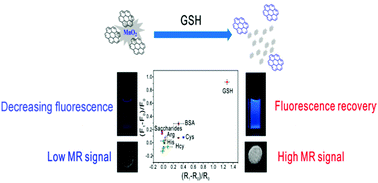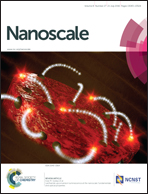A magnetic/fluorometric bimodal sensor based on a carbon dots–MnO2 platform for glutathione detection†
Abstract
A novel magnetic/fluorometric bimodal sensor was built from carbon dots (CDs) and MnO2. The resulting sensor was sensitive to glutathione (GSH), leading to apparent enhancement of magnetic resonance (MR) and fluorescence signals along with visual changes. The bimodal detection strategy is based on the decomposition of the CDs–MnO2 through a redox reaction between GSH and MnO2. This process causes the transformation from non-MR-active MnO2 to MR-active Mn2+, and is accompanied by fluorescence restoration of CDs. Compared with a range of other CDs, the polyethylenimine (PEI) passivated CDs (denoted as pCDs) were suitable for detection due to their positive surface potential. Cross-validation between MR and fluorescence provided detailed information regarding the MnO2 reduction process, and revealed the three distinct stages of the redox process. Thus, the design of a CD-based sensor for the magnetic/fluorometric bimodal detection of GSH was emphasized for the first time. This platform showed a detection limit of 0.6 μM with a linear range of 1–200 μM in the fluorescence mode, while the MR mode exhibited a linear range of 5–200 μM and a GSH detection limit of 2.8 μM with a visible change being observed rapidly at 1 μM in the MR images. Furthermore, the introduction of the MR mode allowed the biothiols to be easily identified. The integration of CD fluorescence with an MR response was demonstrated to be promising for providing detailed information and discriminating power, and therefore extend the application of CDs in sensing and imaging.


 Please wait while we load your content...
Please wait while we load your content...